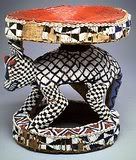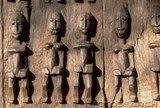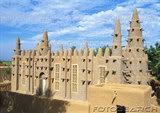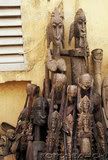Friday, June 1, 2007
African Roots of Humanity_and Civilization - Part II
THE AFRICAN PRESENCE IN ASIA
The First Asians
The earliest modern human (Homo sapiens sapiens) populations of Asia were also of African birth. Here we are speaking of the Diminutive Africoids--the extremely important and much romanticized family of Black people phenotypically characterized by: unusually short statures; skin-complexions that range from yellowish to dark brown; tightly curled hair; and, in frequent cases (like many other Blacks), steatopygia. They are probably more familiar to us by such pejorative terms as pygmies," "negritos" and "negrillos." Similar peoples who live today in Southern Africa have been titled Bushmen." More accurate names for these latter people are San (translated as "original inhabitants").
Moving slowly and sporadically from their African birthplace, beginning perhaps 100,000 years ago and continuing through the millennia, untold numbers of Diminutive Africoids began to people Asia. Although they currently exist in limited numbers, and are generally found in heavily forested, barren, isolated or similarly forbidding terrains, the Diminutive Africoids were at one time the supreme lords of the earth. It is indeed unfortunate that the histories of the Diminutive Africoids, including distinct and fundamental contributions to monumental civilizations characterized by agricultural science, metallurgy, advanced scripts and urbanization, are so little understood.
Next, in the sequence of the Black presence in Asia, were the Afro-Australoids. These are the Blacks who spread into Asia, and ultimately Australia itself, at least 50,000 years ago. What the forces and factors were that gave rise to their migratory movements we do not know. Like the Diminutive Africoids, no comprehensive histories of the Afro-Australoids have been written, and all we really have are the tattered and tantalizing fragments of what this archaic period must have been like.
The Afro-Australoids constituted a significant factor in the initial peopling of South Arabia; with their skeletal remains also having been exhumed from sites in Iraq. In South Asia they proliferated, and are six million strong today in eastern and central India, where they are known as Mundas and Kolarians. A Munda sub-group, the Gonds, form the root word of the semi-mythical, submerged continent of Gondwanaland, reputed to have formed an extensive land-bridge joining East Africa to South Asia. The Veddas--an Afro-Australoid population in Sri Lanka, represent the oldest known occupants of that island-nation.
It was perhaps waves of Afro-Australoids, who, characterized by straight to wavy hair textures, and dark to near black complexions, after having ventured into the northeastern stretches of Asia, through a process that is only vaguely understood, diverged from the original parent stock into the Mongoloid or "yellow" ethnic types of modern times.
Eastern Asia
Certainly, traces of Blacks have been found in both the prehistoric and historic periods throughout the latitudes of northeastern Asia. A recent Associated Press report, for example, stated that, "The oldest Stone Age hut in Japan has been unearthed near Osaka.... Archeologists date the hut to about 22,000 years ago and say it resembles the dugouts of African bushmen." A Japanese proverb states that "Half the blood in one's veins must be black to make a good Samurai." We also have knowledge, in Japan, of Sakanouye Tamura Maro (ca. 800 C.E.), the Black general who led the Japanese armies into battle against the Ainu. Tamura Maro's successful generalship ultimately won him the Japanese shogunate.
In China an Africoid presence is visible from remote antiquity through the major historical periods. The Shang, for example, China's first dynasty, apparently had a Black background, so much so that the conquering Chou described them as having "black and oily skin." The famous Chinese sage, Lao-Tze (ca. 600 B.C.E.), was "black in complexion." Lao-Tze was described as "marvelous and beautiful as jasper." Magnificent and ornate temples were erected for him, inside of which he was worshipped like a god.
Funan is the name given by Chinese historians to the earliest kingdom of Southeast Asia. Its builders were a Black people known as Khmers, a name that loudly recalls ancient Kmt (Egypt). In remote antiquity the Khmers seem to have established themselves throughout a vast area that encompassed Myanmar, Kampuchea, Laos, Malaysia, Thailand and Vietnam. Emerging during the third century, the kingdom of Funan spread over southern Kampuchea and Vietnam. A Chinese observer described the Funanese men as small and black, and noted the Khmer's impressive libraries and high regard for scholars.
The story of Southeast Asia's Black kingdoms is essentially the story of the African people in early Asia itself: the creators and innovators of nation-states and powerful civilizations, only to be overwhelmed in the end. The Black presence in Asia, however, has been deeply etched, and the Asian nations of today, whether conscious of it or not, have merely raised themselves under a guiding African tutelage.
Western Asia
Sumer (the Biblical land of Shinar) was the formative civilizing influence in early West Asia. Flourishing during the third millennium B.C.E., Sumer set the tone and established the guidelines for the kingdoms and empires which succeeded her. Frequently designated as, or linked with, Chaldea and Babylonia, Sumer embraced the Tigris/Euphrates river valley from the base of the Persian Gulf north to Akkad, a distance of about 300 miles.
While Sumer's many cultural and technical achievements are much celebrated, the important question of her ethnic composition is frequently either glossed over or left out of the discussion altogether. Independent and objective study of the available data however, reveals the very real question of whether the so-called "problem of Sumerian origins" is actual or artificial. The Sumerians did, after all, refer to themselves as "the Blackheaded people," and their most powerful and pious leaders, such as Gudea, consistently chose very dark (and preferably black) stone for their statuary representations. There is also no doubt that the oldest and most exalted deity of the Sumerians was Anu, a name that loudly recalls the thriving and widely-spread Black civilizers found at history's dawn in Africa, Asia and even Europe. Eye-witness accounts, religious similarities, linguistic affinities, skeletal evidence, Biblical references, architectural patterns, and oral traditions all point to an early African origin for the Sumerians of Iraq.
Elam was the first civilization of Iran (formerly called Persia), and shared Sumer's eastern border. Diop points to the Africoid presence in early Elam, focusing especially on the region's artistic and sculptural remains identified by Marcel Dieulafoy from his late nineteenth century excavations at Susa. The district of Susa was generally thought by the ancients to be the residence and capital city of Memnon--the illustrious Black warrior-king. The heroic story of Memnon--his courage and prowess at the siege of Troy--was one of the most widely circulated and celebrated of antiquity. Memnon is mentioned repeatedly in the works of such writers as Aeschylus, Apollonius of Tyana, Athenaeus, Catullus, Dio Chrysostom, Hesiod, Ovid, Pausanias, Philostratus, Pindar, Quintus of Smyrna, Seneca, Diodorus Siculus, Strabo and Virgil. Arctinus of Miletus composed an epic poem entitled Ethiopia in which Memnon was the leading figure.
Quintus of Smyrna credits Memnon with "bringing the countless tribes of his people who live in Ethiopia, land of the black man," to Priam's Troy in support of his war for survival against the hostile coalition of Greek city-states. "Memnon came to help them. Memnon was lord over the dark Ethiopians, and the host be brought seemed infinite. The Trojans were delighted to see him in their city."
Herodotus (ca. 450 B.C.E.) regarded Colchis, a land located along the western slope of the Caucasus mountains near the Black Sea and considered the home of the Golden Fleece in Greek mythology, as an actual Kemetic colony. He not only pointed to the Colchians' black skin and woolly hair, but also to their oral traditions, language, methods of weaving, and practice of circumcision. He notes that:
"It is undoubtedly a fact that the Colchians are of Egyptian descent. I noticed this myself before I heard anyone else mention it, and when it occurred to me I asked some questions both in Colchis and in Egypt, and found that the Colchians remembered the Egyptians more distinctly than the Egyptians remembered them. The Egyptians did, however, say that they thought the original Colchians were men from Sesostris' army. My own idea on the subject was based first on the fact that they have black skins and woolly hair (not that that amounts to much, as other nations have the same), and secondly, and more especially, on the fact that the Colchians, the Egyptians, and the Ethiopians are the only races which from ancient times have practised circumcision.... There is a further point of resemblance between the Colchians and the Egyptians: they share a method of weaving linen different from that of any other people."
Saint Jerome, writing during the fourth century, called Colchis the "Second Ethiopia." Two hundred years later, Sophronius, patriarch of Jerusalem, described an "Ethiopian" presence in the same region. Even today, in the same district about which Herodotus wrote, exists a minute black-skinned and woolly-haired community.
Phoenicia was the name given by Greeks in the first millennium B.C.E. to the coastal provinces of modern Lebanon and northern Palestine, although occasionally the term seems to have been applied to the entire Mediterranean seaboard from Syria to Palestine. Phoenicia was not considered a nation, in the strict sense of the word, but rather as a chain of coastal cities, of which the most important were Sidon, Byblos, Tyre and Ras Shamra. To the Greeks, the term Phoenician, from the root "Phoenix," had connotations of "red," and it is likely that the name was derived from the physical appearance of the people themselves.
The Phoenicians were a coastal branch of the Canaanites, who, according to Biblical traditions, were the brothers of Kush (Ethiopia) and Mizraim (Egypt): members of the Hamite, or Kamite, ethnic family. The Bible says that the Canaanites, Ethiopians and Egyptians were all Black and of Nile Valley origin. Diop claims that "Phoenician history is therefore incomprehensible only if we ignore the Biblical data according to which the Phoenicians, in other words, the Canaanites, were originally Negroes, already civilized, with whom nomadic, uncultured white tribes [as represented by Abraham] later mixed." From this period, towards the middle of the second millennium B.C.E., the term Leuco (White) Syrians came to be applied to the newly arrived populations. Ultimately, says Diop, the people of Abraham and the already settled Canaanites fused to become the historical Hebrews. It was among the Canaanite peoples that one of the most momentous inventions in human history is attested--the alphabet.
While acknowledging the Biblical data, the economic relations shared by the Kamites and the Phoenicians should not be minimized in explaining the strong sense of solidarity which generally existed between them. There was frequently a Kemetic presence: military, diplomatic, religious or commercial, both in the Canaanite hinterland and the Phoenician city-states themselves, and Diop goes on to state that, "Even throughout the most troubled periods of great misfortune, Egypt could count on the Phoenicians as one can count more or less on a brother."
Spurred on by increasing population pressures, the Phoenicians, who were becoming increasingly mixed racially, had, by the middle of the second millennium B.C.E. developed a prowess on the seas, and were in the process of establishing a network of colonies and trading posts that not only brought them fame and prosperity, but introduced in some cases, and reinforced in others, vital elements of the cultural attributes of the Southern world. Phoenician inscriptions have been found as far north as central Turkey and at least as far west as Tunisia, where the famous ancient city of Carthage was founded.
The Arabian peninsula, first inhabited more than 8,000 years ago, was early populated by Blacks. Once dominant over the entire peninsula, the African presence in early Arabia is most clearly traceable through the Sabeans. The Sabeans were the first Arabians to step firmly within the realm of civilization. The southwestern corner of the peninsula was their early home. This area, which was known to the Romans as Arabia Felix, embraces the country that is today called Yemen. In antiquity this region gave rise to a high degree of civilization because of the fertility of the soil, the growth of frankincense and myrrh, and the close proximity to the sea and consequently its importance in the trade routes. The Sabeans have even been called "the Phoenicians of the southern seas."
On of the earliest known Sabean construction project was probably the Marib Dam (possibly South Arabia's most enduring technical achievement). Serving the South Arabians for more than a thousand years, the Marib Dam is traditionally believed to have been conceived by Lokman, the sage and multi-genius of pre-Islamic South Arabia. In effect, the Dam was an earthen ridge stretching slightly more than 1700 feet across a prominent wadi. Both sides sloped sharply upward, with the Dam's upstream side fortified by small pebbles established in mortar. The Marib Dam was rebuilt several times by piling more earth and stone onto the existing structure. The last recorded height of the Marib Dam was slightly more than forty-five feet.
Before the advent of Islam southern Arabia already possessed the sacred Kaaba sanctuary, with its black stone, at Makkah. Diop claimed that "The Kaaba was reputed to have been constructed by Ishmael, son of Abraham and Hagar the Egyptian (a Negro woman), historical ancestor of Mohammed, according to all Arab historians." "In Egypt he [Abraham] had married a Negro woman, Hagar, mother of Ishmael, the Biblical ancestor of the second Semitic branch, the Arabs. Ishmael was said to be the historical ancestor of Mohammed."
The city of Makkah was considered a holy place and the destination of pilgrims long before the prophet Muhammad. Muhammad himself, who was to unite the whole of Arabia, appears to have had a prominent African lineage. According to al-Jahiz, the guardian of the sacred Kaaba--Abd al-Muttalib, "fathered ten Lords, Black as the night and magnificent." One of these men was Abdallah, the father of Muhammad. According to tradition, the first Muslim killed in battle was Mihdja--a Black man. Another Black man, Bilal, was such a pivotal figure in the development of Islam that he has been referred to as "a third of the faith." Many of the earliest Muslim converts were Africans, and a number of the Muslim faithful sought refuge in Ethiopia because of Arabian hostility to Muhammad's teachings.
Southern Asia
The ancient riverine civilization of the Indus Valley (named after one of its largest and most studied sites--Harappa) actually had extensions reaching from the river Oxus in Afghanistan in the north to the Gulf of Gambay in India in the south. The Harappan civilization flourished from about 2200 B.C.E. to approximately 1700 B.C.E. At its height, the Harappans engaged in regular commercial relations with Iraq and Iran. This much we know with certainty. We are equally certain that the founders of the Harappan civilization were Black. This is verifiable through the available physical evidence--skeletal remains, eye-witness accounts preserved in the Rig Veda, artistic and sculptural remains, the regional survival of Dravidian languages (including Brahui, Kurukh, and Malto) and the essential role of these languages which are now being used in the decipherment of the Harappan script. We should also take into account the prominence accorded the mother goddess in the Harappan cities and the sedentary nature of the Harappan people themselves. Walter Fairservis claims that the "Harappans cultivated cotton and perhaps rice, domesticated the chicken and may have invented the game of chess and one of the two of the great early sources of nonmuscle power: the windmill."
Exceptionally valuable writings expressing intimate connections between early India, Egypt and Ethiopia have existed for more than two thousand years. In the first century B.C.E., for example, the famous Greek historian Diodorus Siculus penned that, "From Ethiopia he (Osiris) passed through Arabia, bordering upon the Red Sea as far as to India....He built many cities in India, one of which he called Nysa, willing to have remembrance of that (Nysa) in Egypt where he was brought up." Apollonius of Tyana, who is said to have visited India near the end of the first century C.E., was convinced that "The Ethiopians are colonists sent from India, who follow their forefathers in matters of wisdom." The Itinerarium Alexandri, a Latin work written about 345 C.E. for the Roman emperor Constantius, says that, "India, taken as a whole, beginning from the north and embracing what of it is subject to Persia, is a continuation of Egypt and the Ethiopians."
The epic story of the African presence in Asia is one of the most exciting and, yet, least known aspects of the Black experience. It spans a period of more than 100,000 years and encompasses the largest single land mass on earth. Although many are startled by the notion, it is absolutely undeniable, that: as the first hominids and modern humans; as simple hunter-gatherers and primitive agriculturists; as heroic warriors and premier civilizers; as sages and priests, poets and prophets, kings and queens; as deities and demons of misty legends and shadowy myths; and yes, even as servants and slaves, the Black race has known Asia intimately from the very beginning. Even today, after an entire series of holocausts and calamities, the numbers of Blacks in Asia approach two-hundred million. The Black populations of Asia, what they have done and are now doing, are questions that beg and demand serious answers. These answers, which we must diligently seek to supply, cannot be sought merely to satisfy the intellectual curiosity of an elite group, but to further the vision of Pan-Africanism and reunite a family that has been separated far too long.
Labels: Part II African Roots of Humanity and Civilization - Asia
Subscribe to Comments [Atom]







